Returning from my last trip to Beneteau at the French Atlantic coast of the Vendeé, I took a slight detour: Usually, I drive directly via Paris back to Germany. This time however, my routing was taking me up North a bit. Not through Belgium but through our Northern neighbor: The Netherlands. As the interior building process of my Omega 42 sailboat is commencing, I start to buy the items for the next big thing on the bucket list – the deck.
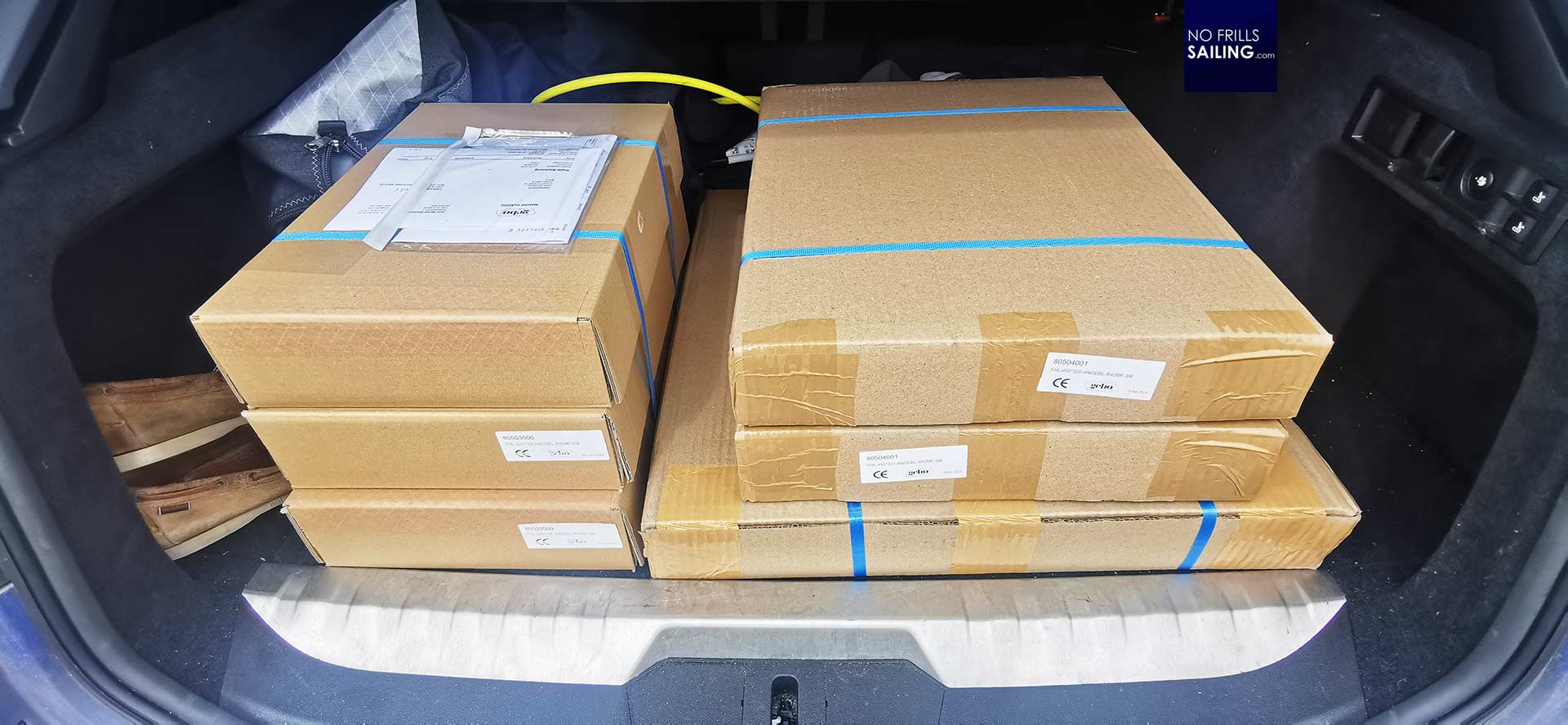
The essential deck gear, predominantly the winches are already bought and delivered to my shipyard – of course, it´s the high quality of Andersen winches, this time the boatbuilders asked me to deliver the deck hatches, portholes and windows. This is an essential part because holes need to be cut out of the GRP deck and those parts fitted before the marriage of hull and deck. Arriving back home in Luebeck, I open the trunk of my car: Three deck hatches (two skylights and one big hatch that functions as escape hatch as well) and three smaller opening portholes are the first of two deliveries. Of course, I didn´t buy cheap China-made equipment. I just arrive back from Gebo, one of the last true European marine specialists.
A 50 years old company in Holland
You know that I just love those stories, I´ve wrote about it many times (you´ll find three familiar articles on brands and products at the end of this article). Gebo is a small company that is based in Almere, vis-à-vis from the Dutch capital of Amsterdam. Founded more than 50 years ago, the company is located in a modern, plain industrial building that is situated in a trade park. No fancy façade, no exaggerated representative entrée: Just the humble, Calvinist functionality of a purpose-built location. I have an appointment with Alan Bekendam, Export Manager and the one who sold me the hatches for my Omega. He greets me at the entrance, the factory tour starts right away.
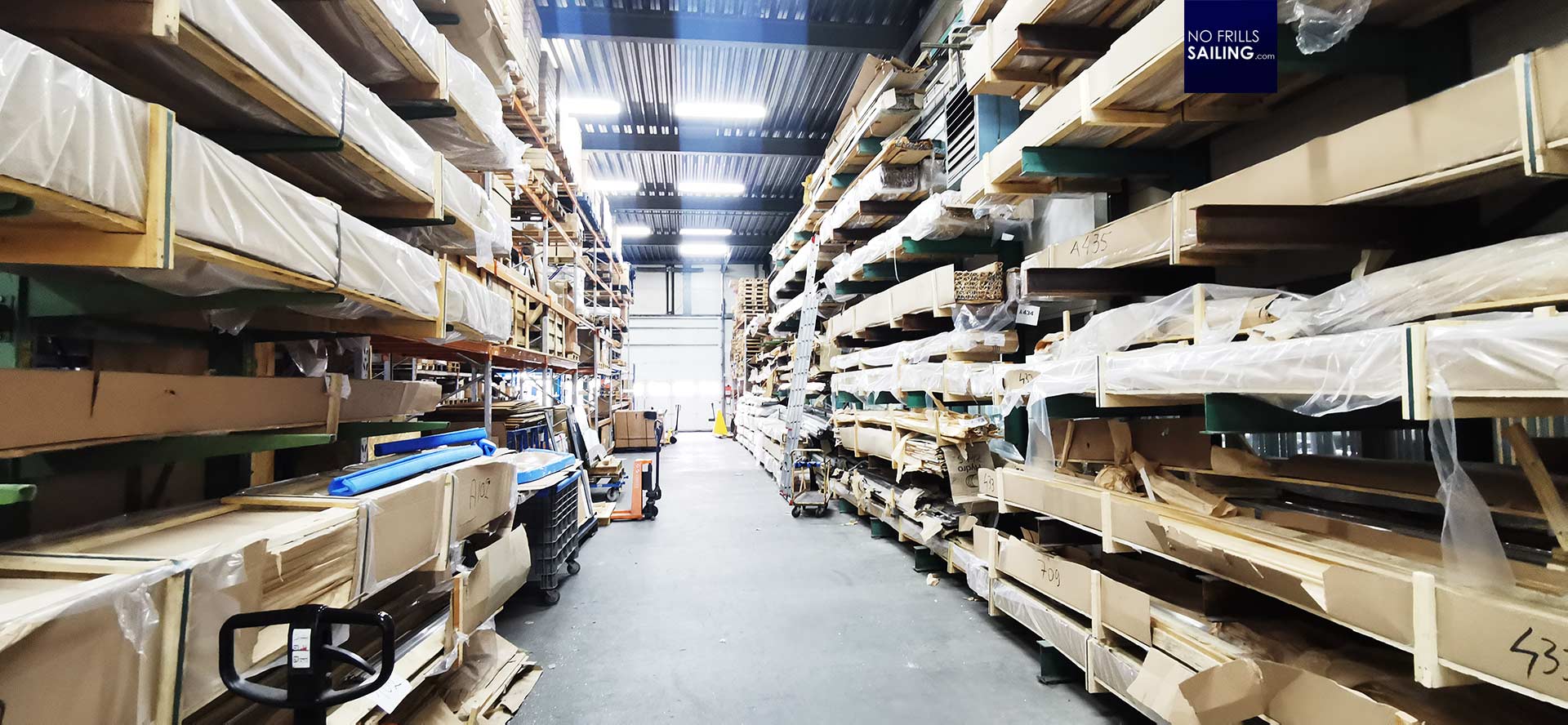
Where other brands might present a larger representative area, Gebo just skips all that showing off. Entering the building it´s a tiny showroom (full of displays waiting for the next boat show), adjoining some small offices. All of a sudden we find ourselves within the very production. I ask Alan if there are any secrets or sensitive areas I shouldn´t take pictures of. He nods: There´s nothing secret about the production, he says: “Feel free to photograph whatever you like.” This is confidence. Gebo, he says is fully booked and production is ramped up. There was a small dent during Corona, but not on the buyer side but because delivery of raw material and parts was stuck. Now the laydown of the production is well stocked again – there is no crisis, at least for Gebo.
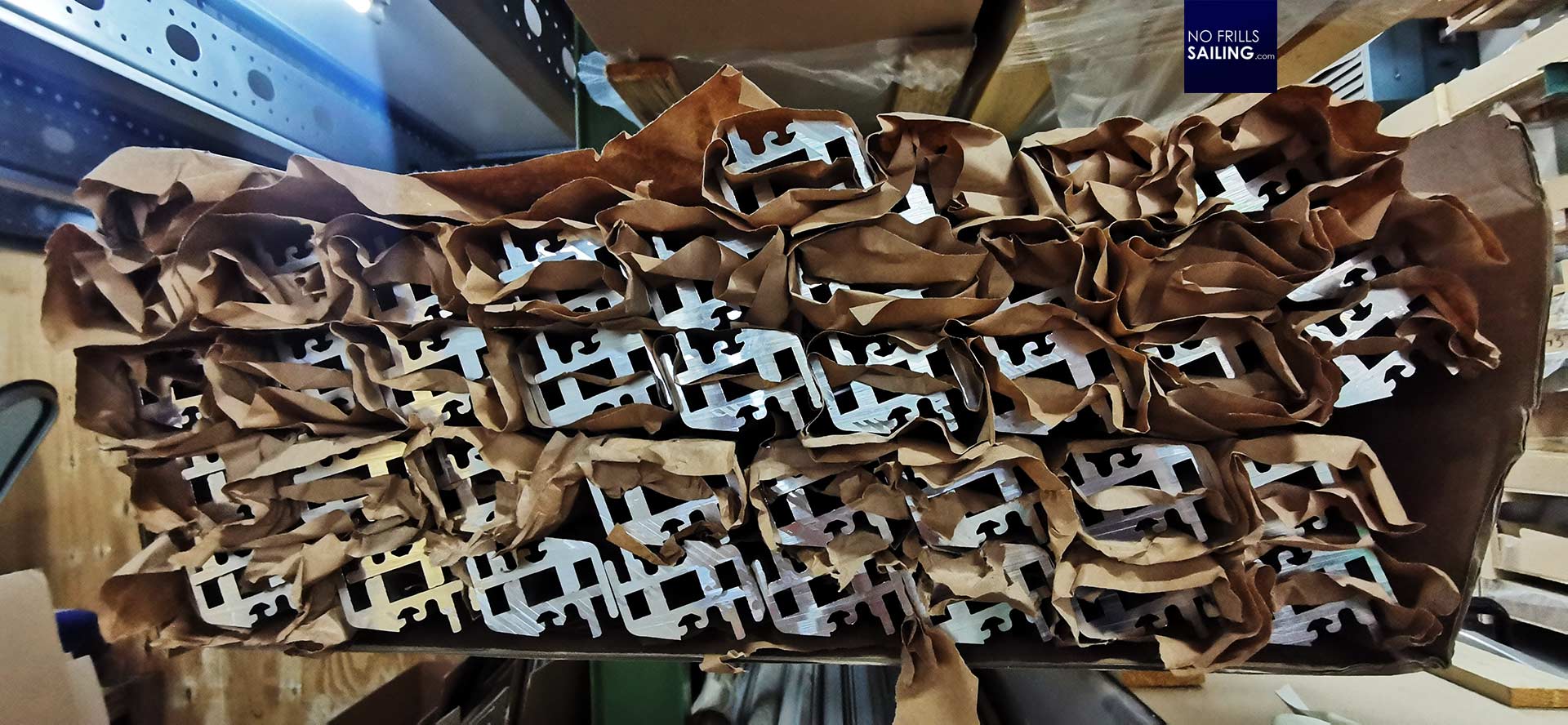
Not unlike the production of a sailboat´s mast – which I have documented during my visit to the Seldén factory a few months ago – the most important base materials are the various profiles. Those are made of aluminum solely, Gebo does not offer windows or hatches made of plastic. All frames are aluminum-based which comes with a variety of advantages. The quality is high and remains so even after many, many years. The harsh marine environment won´t degrade the integrity of the structures as much as it does to plastic parts, thus, value and safety will stay high throughout the even longer product life of a hatch made like this. I can only agree: Remembering how I refitted my Gebo hatches on my first boat, the King´s Cruiser 33, some years ago, I back then was astonished that in principle those “old” hatches were pretty much looking like new.
The deck hatch: A 100 % handcrafted product
A deck hatch, a porthole or a boat window is an all-out handmade product. I don´t know what I was expecting, but I indeed was amazed to learn that there are no robots whatsoever apparent in Gebo´s production. We went a few meters to a workstation where a friendly staff member was operating a large bending machine. Looking around, I see many of those dedicated workplaces where larger and smaller machines and staging areas for raw material and finished products were located.
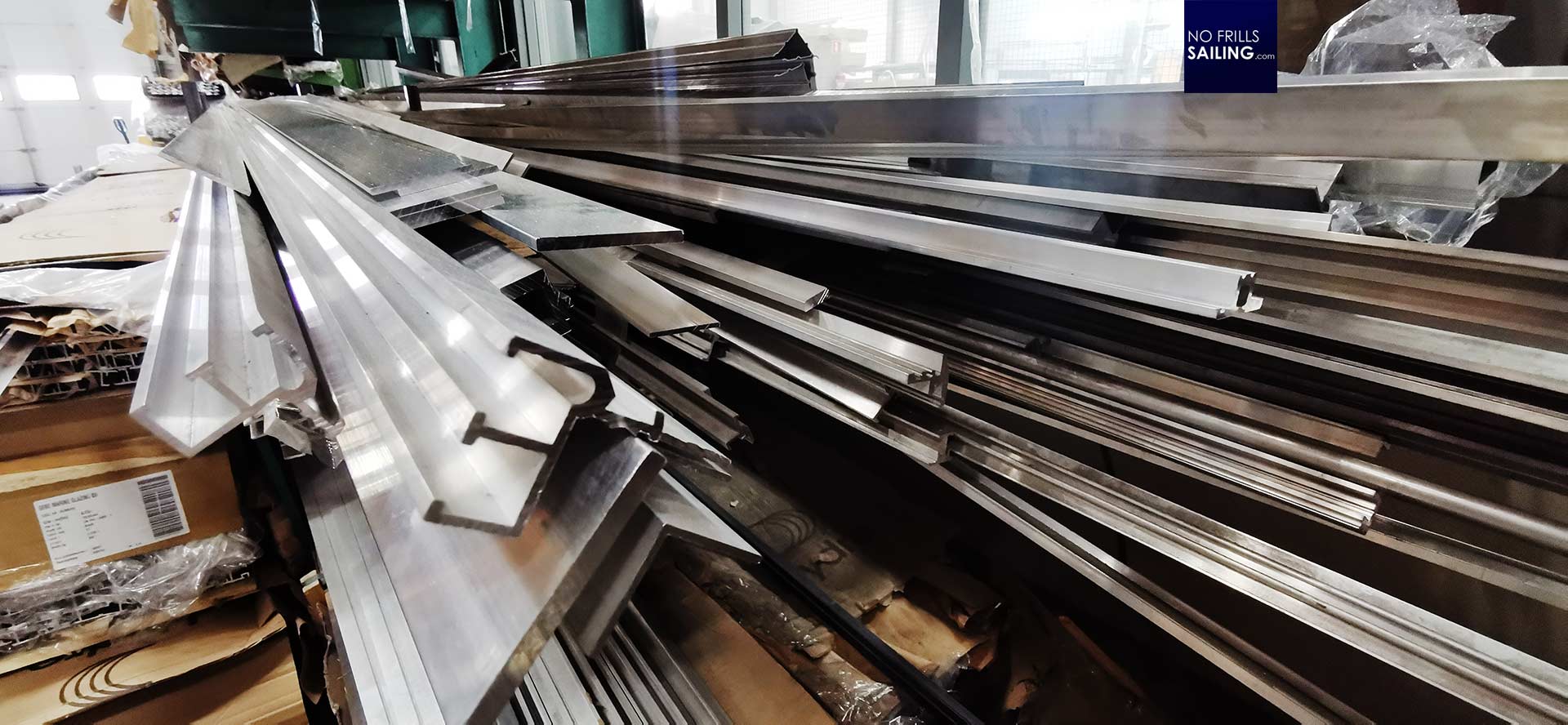
Alan tells me that at Gebo roughly twenty people are working in total. A surprisingly small workforce for a company that delivers its products to so many clients in all over the world. Of those twenty staff members, more than half are working in the actual production: Gebo keeps its overhead in the offices as small and cost-effective as possible. At the same time, the company manages to be very efficient and fast: From my initial first email asking for a price quote for my boat´s hatches to the delivery notice after paying it took just a few days. Quick reaction, efficient production, fast delivery – this is how you do it. But back to the production process …
Bending the aluminum frames
At the bending machines, each straight profile is bent into position. It´s a cold bending process that does not require any thermal or chemical surplus. For a standard deck hatch for example, the profile is bent four times forming the squared frame. The guy takes out a straight aluminum frame and puts it onto a dedicated guide rail on the machine.

Adjusting the position via pre-set markers, he controls the perfect fit according to the data of the product. He then secures the frame to sit tightly in place while pushing a large button with one of his feet. The machine – driven by sheer hydraulic power – then bends the frame around a round steel blank. By that, the diameter of the steel blank is transferred to the once straight frame. Repeating this procedure four times, he will now have a four-squared raw window or hatch frame. If done with utmost precision, both ends of the frame will meet each other – leaving not a fraction of millimeter between the jointing as a gap.
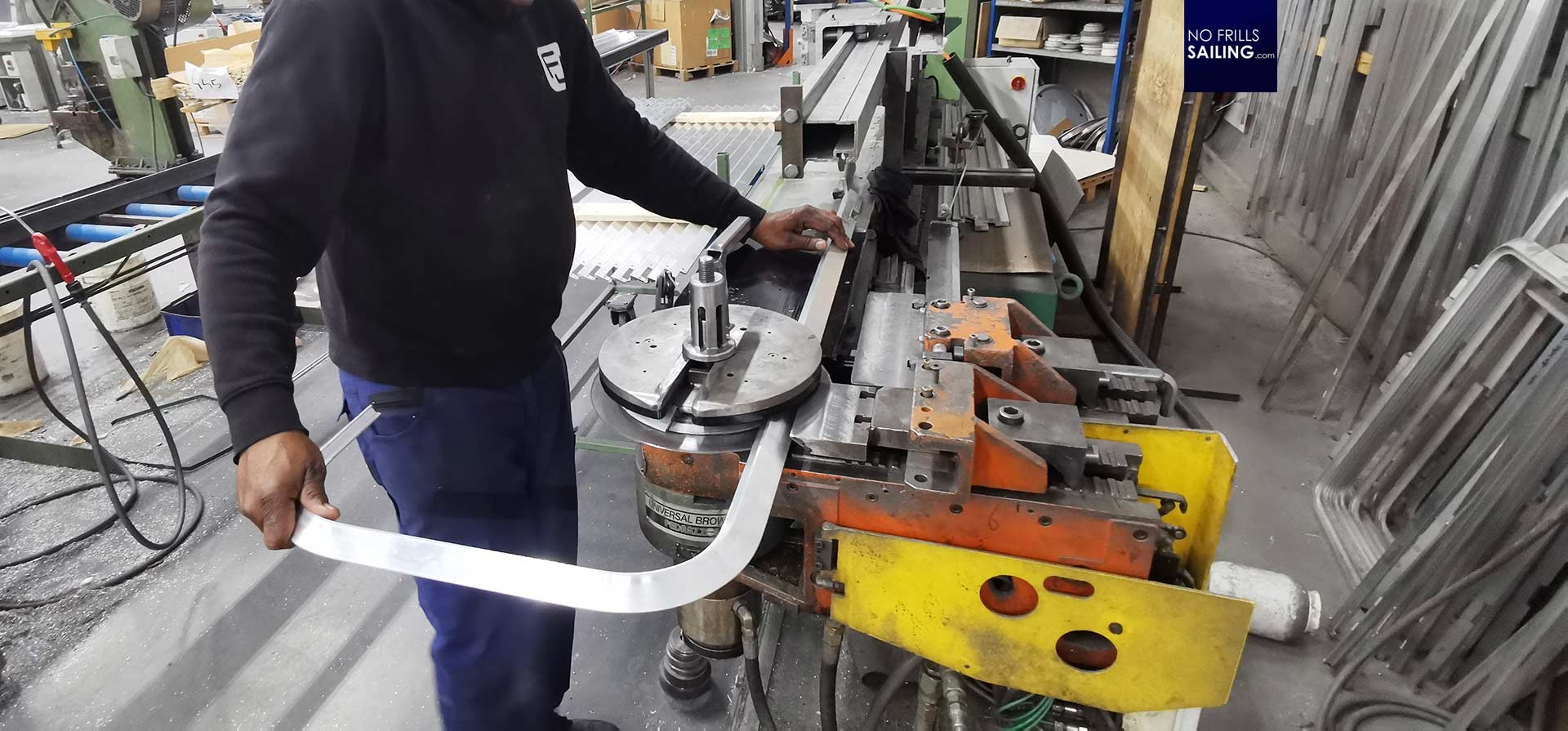
By changing those rounded steel blanks, the frames can be bent in all sorts of sizes regarding the rounded edges. Up until full circles hatches and windows could be made as well. On a rack next to the cold bonding machine I see the full set of blanks nicely set up from small to bigger diameters. It almost looks like some sort of a modern art installation. A compelling display of how many iterations are possible in designing the product.
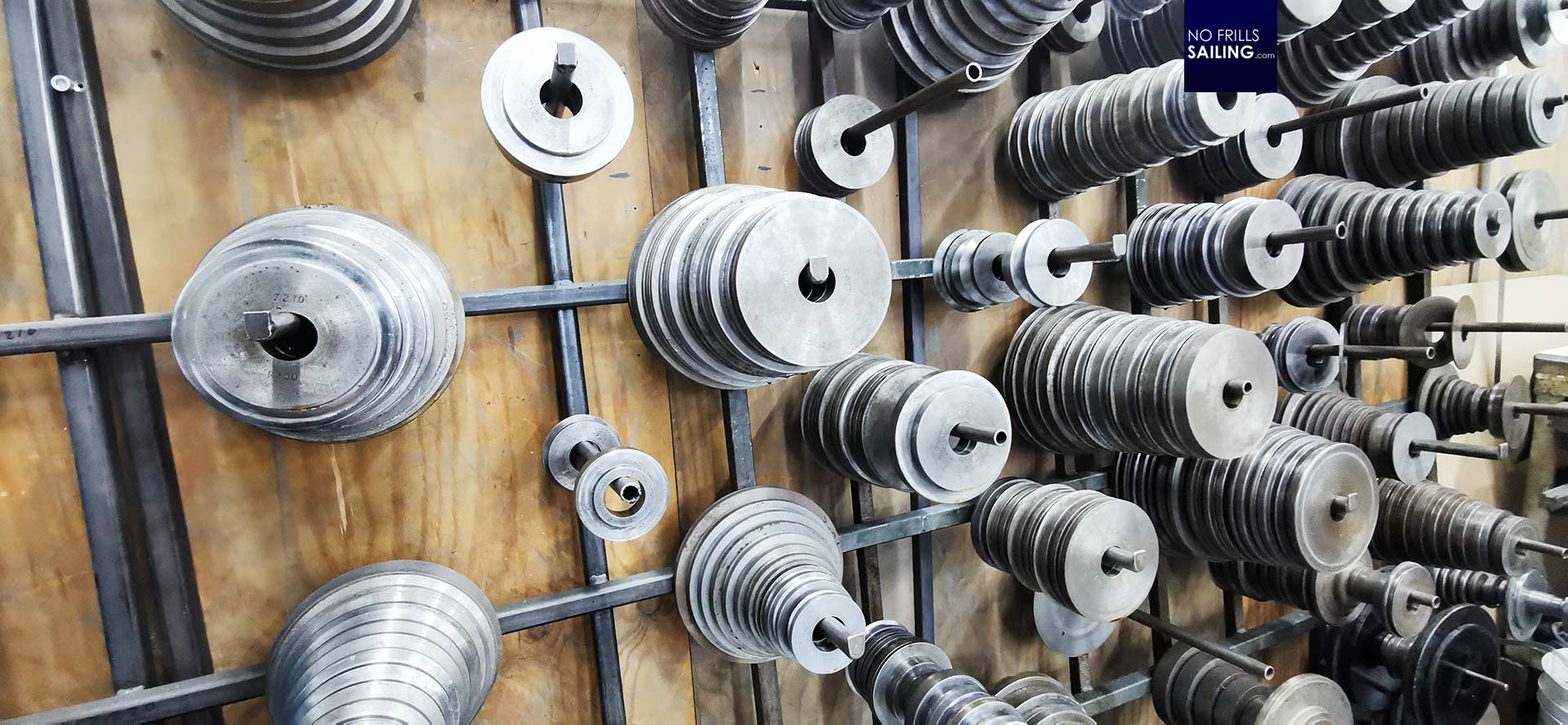
The guy at the machine will produce the desired amount of frames and put them on a rack for further treatment. Gebo offers a wide range of standard products, ranging from opening deck hatches to portholes, both capable to open and close. There is a big variety of standard marine windows as well. Sliding hatches and windscreens can be bought at Gebo too – in short, any marine glazing you´d need on your boat, both sailing and power boats.
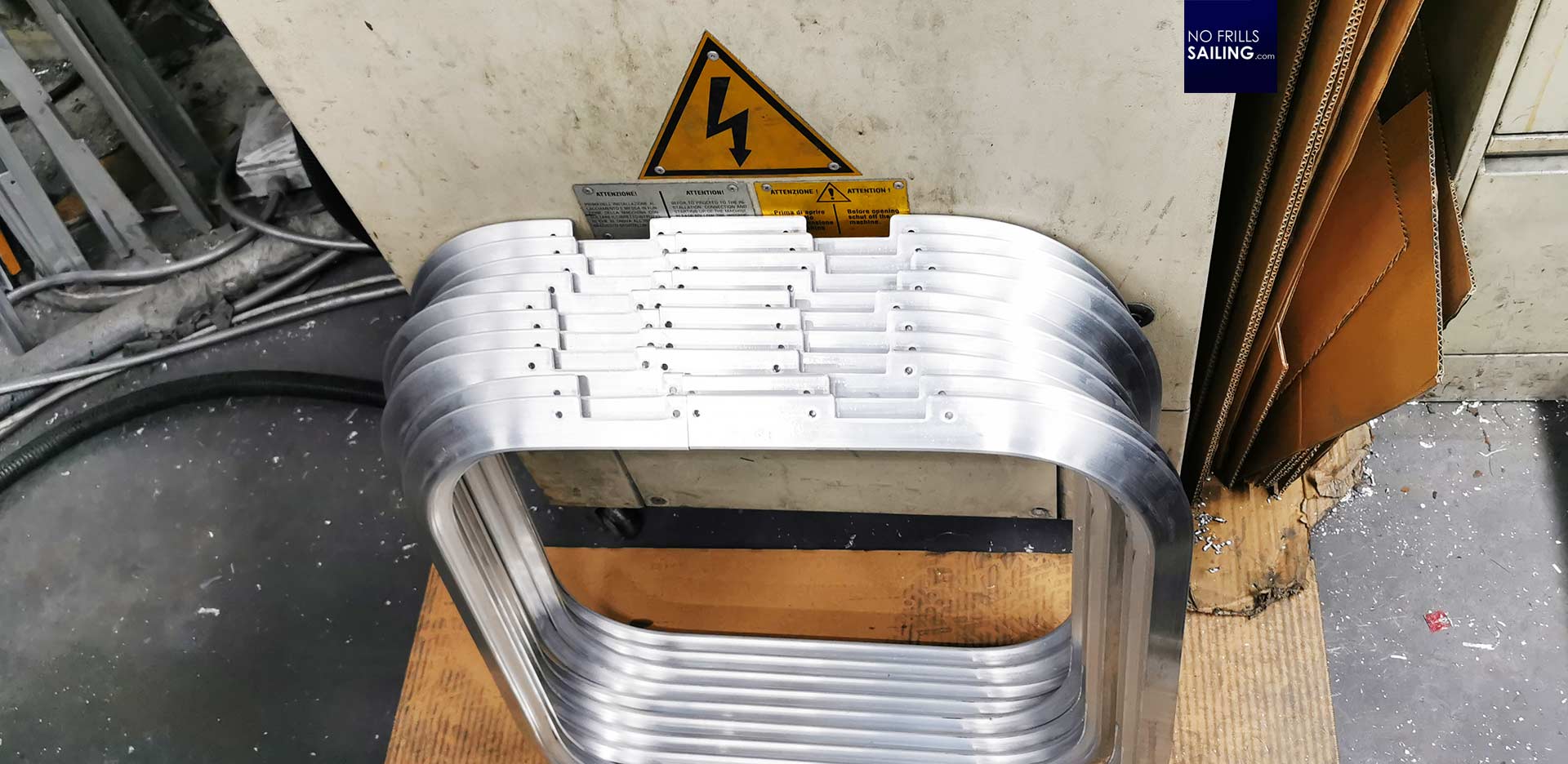
After the raw frames had been made, they are sent to specialized companies for refinement. Gebo offers anodized and powder coated aluminum frames which improve both corrosion resistance and product life. For powder coated frames there´s even less care and maintenance needed as the layer of polyurethane paint will make the frame practically maintenance- and cleaning free. For that, the color of the powder coating can be choose from virtually all RAL-tones of the palette.
Modern machinery meets mechanical art
Did I say it´s a 100 per cent human made product? Well, in fact there is one robot apparent indeed. The CNC milling and drilling machine may be the only computer driven aid of the whole production. Alan explains that before the raw straight profiles will be treated on the bending machine we just saw, this machine is applying all holes, cutouts and applications to the aluminum batten.
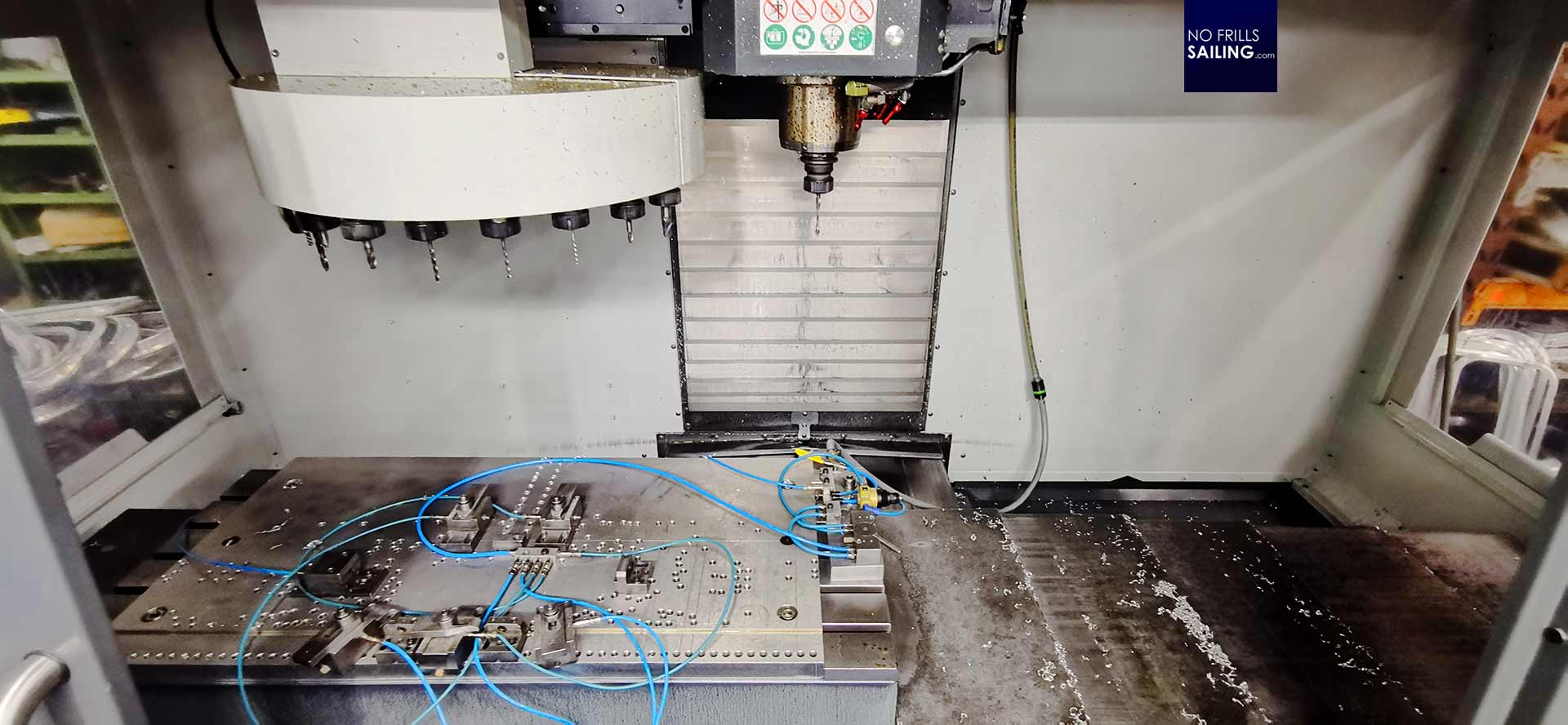
In the past this may have been done by hand using precise gauges, but the computer-driven machine is much faster, much more precise and reliable over time with showing no fatigue or inaccuracies. Although an invest in such a high-precision tool is considerable those machines are more and ore used even in small businesses, which I have seen at our one-man service for Teak and Sapele joinery, the guy that is making our nice Teak gratings and who is currently working on, you guessed it, CNC-milled floorboards.
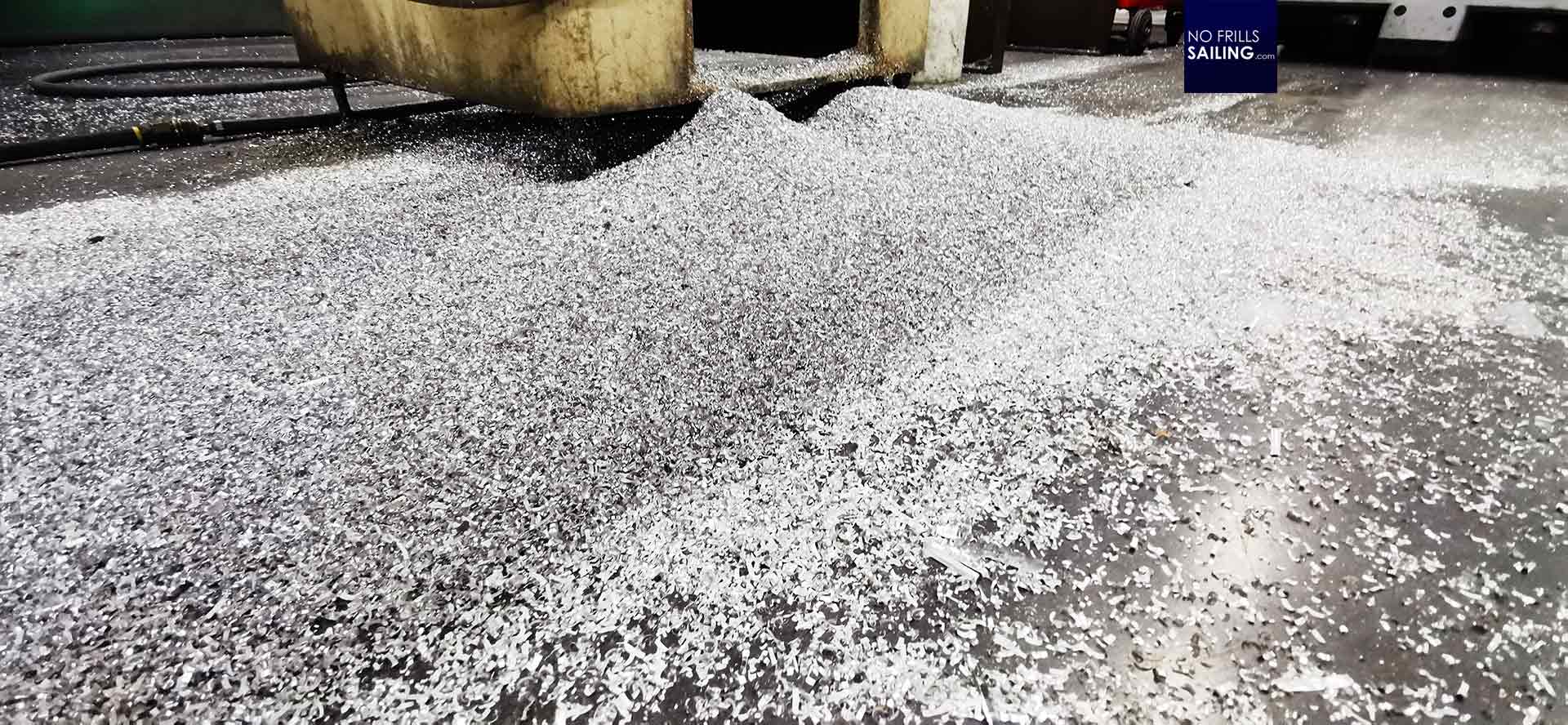
Again, watching the machine closely, it displays an impressive set of almost a dozen different drill bits of various sizes. This is needed to not only drill the wholes of all the diameters as specified but to also make precise abatements to later flush-fit any screws. The amount of metal chips I find nearby is a testament of the filled order books here at Gebo.
The value of a good marine window, hatch and portlight
In the next production step, upon returning from powder coating or anodizing, the different parts of the hatches will be put together. Gebo takes pride in their system of hinges that allow for a 180 degree opening of their deck hatches, a secure stopping at any angle without any need for further installation of supporting the opened hatch and the watertight sealing of their products.
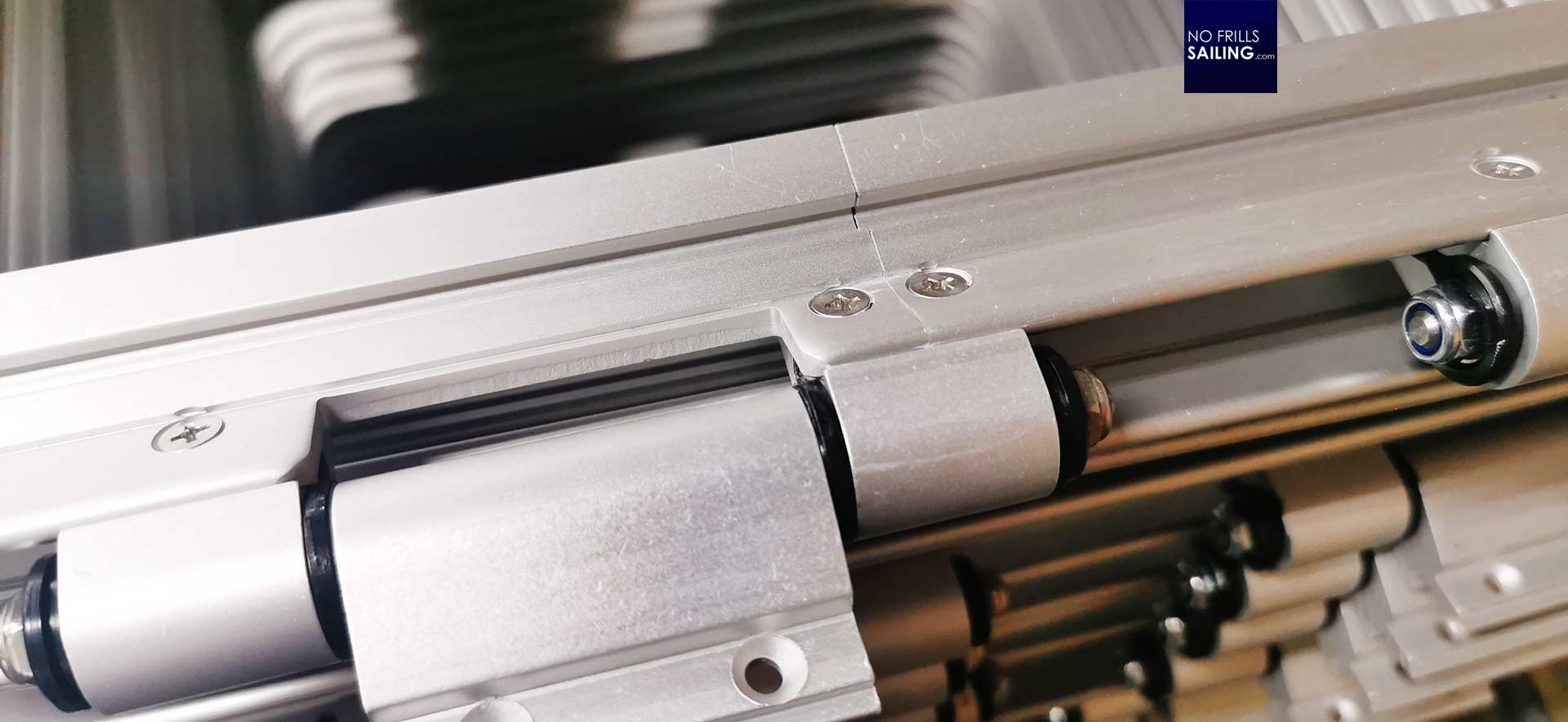
Each hatch, porthole or marine window is of course CE-rated for use in category A, which means open ocean, any weather. Gebo strictly follows not only the CE rules but also a full variety of ISO standards and has all of its products rated, tested and evaluated by Lloyds. To underline their strictness, all of the certificates and for every single product can be downloaded on their website, also citing a contact at the company for any questions. This is what I´d call confidence and full transparency.
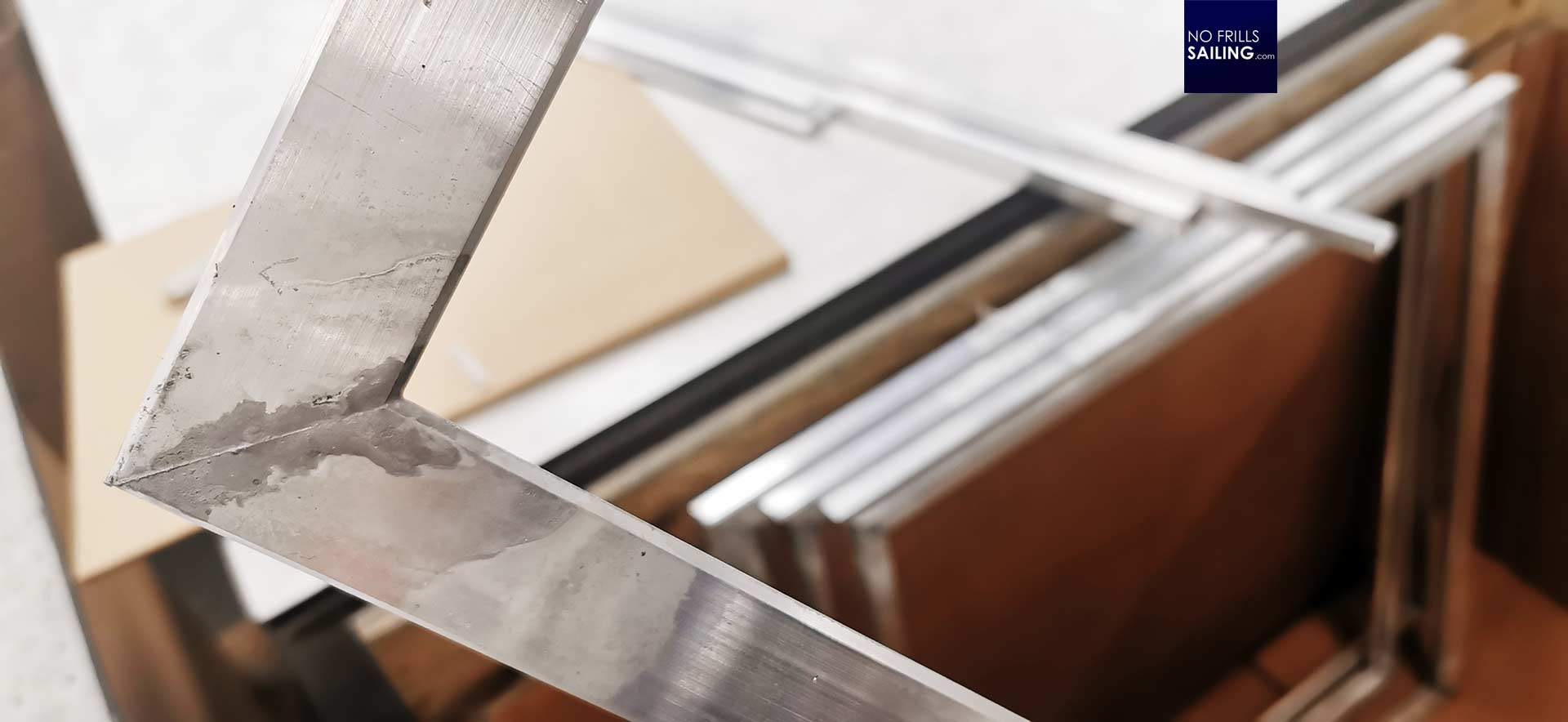
The joints of the frames of the deck hatches do not need to be connected as the will become waterproof by sheer mechanical pressure in the system. That’s different with marine windows, more so when those are used as a structural part of the boat (mostly in power boats). The joints of those frames are welded to form a single part. The joints are later sanded and polished so that on a finished product no seam will be visible anymore.
Glazing the frames
With the frames further going down the production line, it is time for the actual glazing to be fitted. Gebo offers basically two sorts of materials: Acrylic or glass. In this, the variety also is further widened by offering different thicknesses and shades of the material. The company also offers a “thermic” line with tempered glass that is used for boats which are entering very cold areas, utilizing thermic barriers for insulation and prevention of condensation.
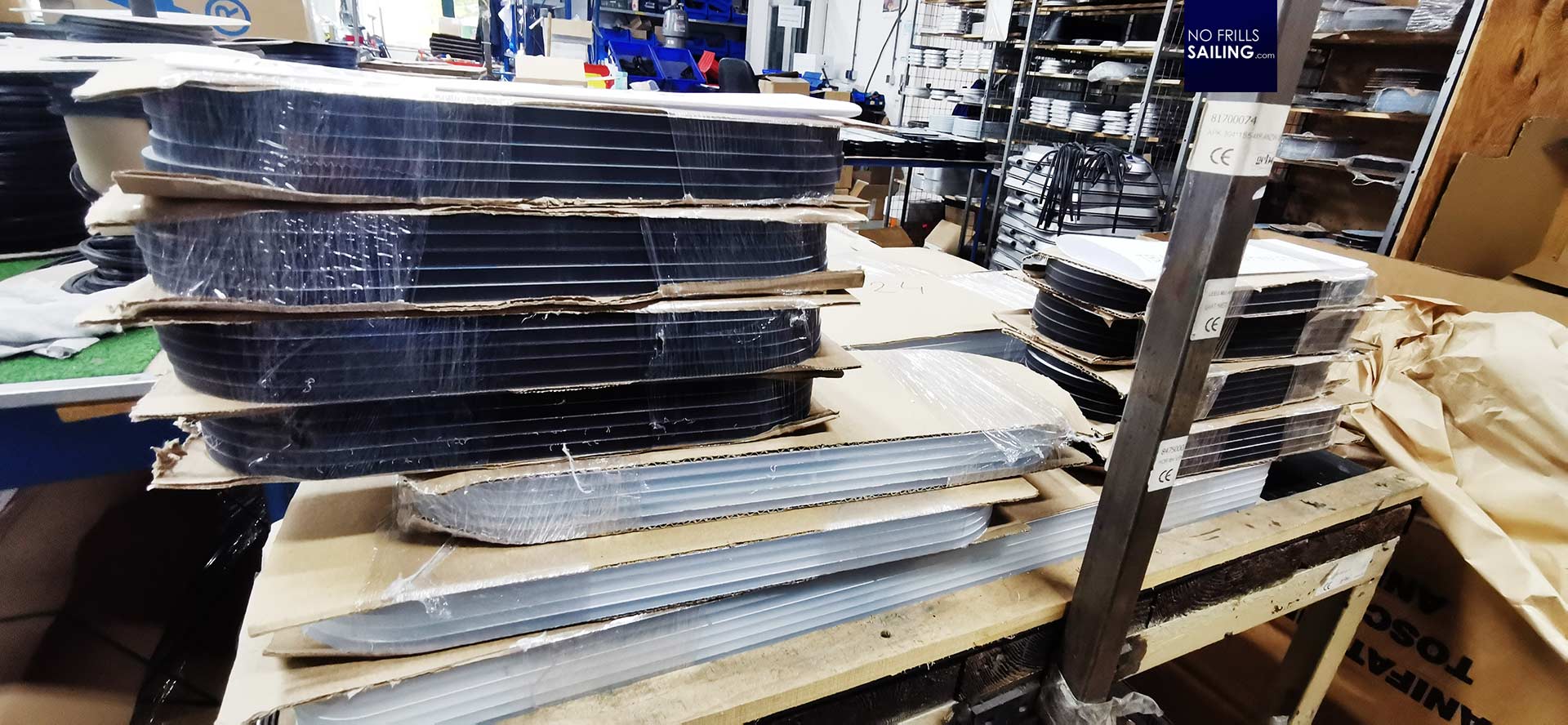
For the standard hatches and portlights, Gebo uses Acrylic. An interesting and defining step in the production is the application of sealant. I know what this is about first hand as I was trying to fit and waterproof the porthole windows to my OLIVIA a few years ago myself: A pretty delicate and deciding process!
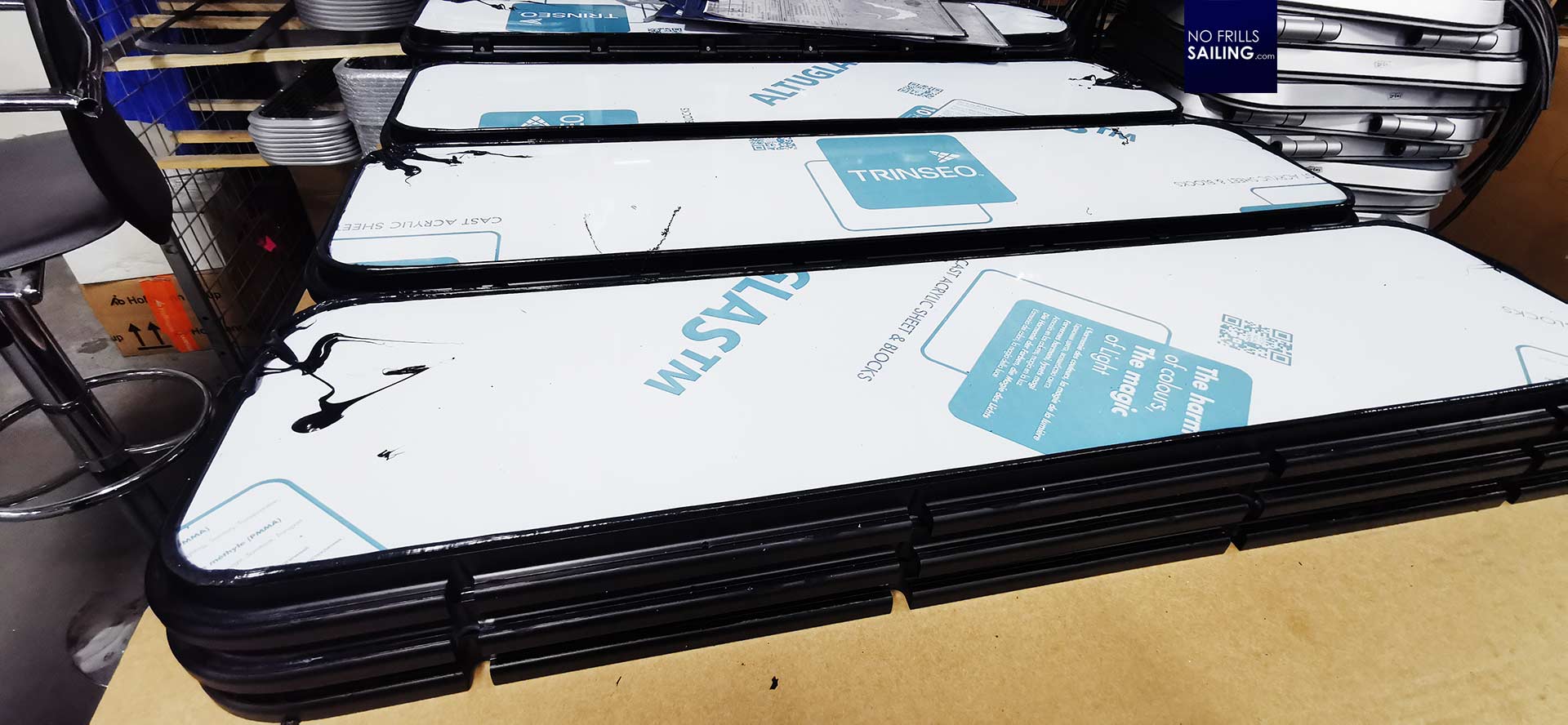
It is important how the sealant is applied, that it is applied with care and in an exact manner so that a watertight layer of material is going all the way around the edge of the glazing or window. If a mistake is made, the window or hatch will be prone to leakage and damage, which, basically amounts to a hole in your yacht – something that simply cannot happen under any circumstance.
Making the hatches waterproof
To ensure that all of the products leaving the company are absolutely waterproof, Alan explains how they do it. First of all, the do not mix hardener or a surplus primer to the sealant. By skipping this, the pure sealant is applied to the glazing. The trick is, as he tells me, to let the material thoroughly dry. Something most companies aren´t willing to invest, is key to Gebo´s approach: Time.
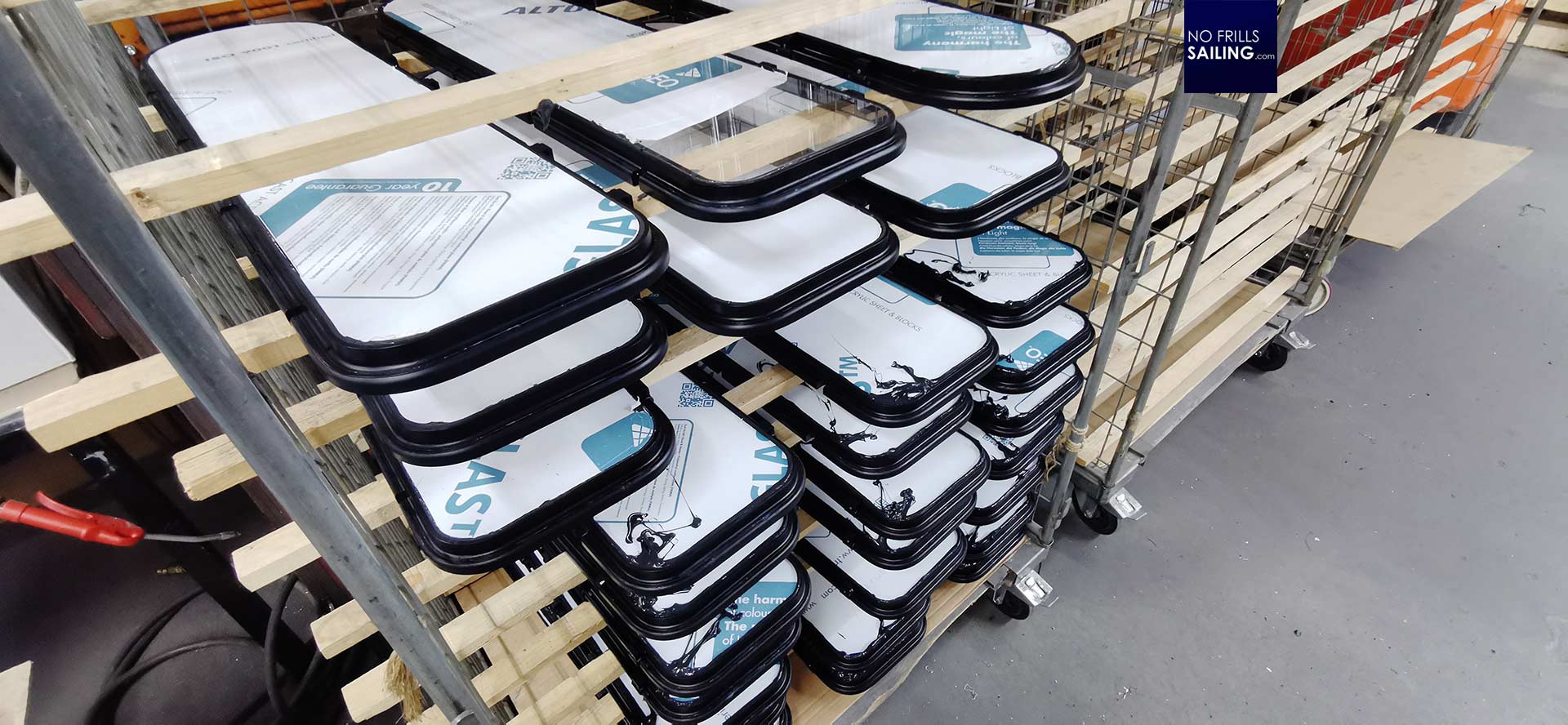
He shows me racks which are piling glazings, windows and partially mounted hatches all the way up just right under the roof of the building. After application of sealant, each part is granted a drying time of a full week! In this, as Alan explains, the pure sealant can thoroughly dry all the way through before the final assembly starts. With bigger or thicker hatches, they would apply sealant in two stages with double the drying time. Again, no hurry, but the good governance and taking on responsibility for the safety of their product.
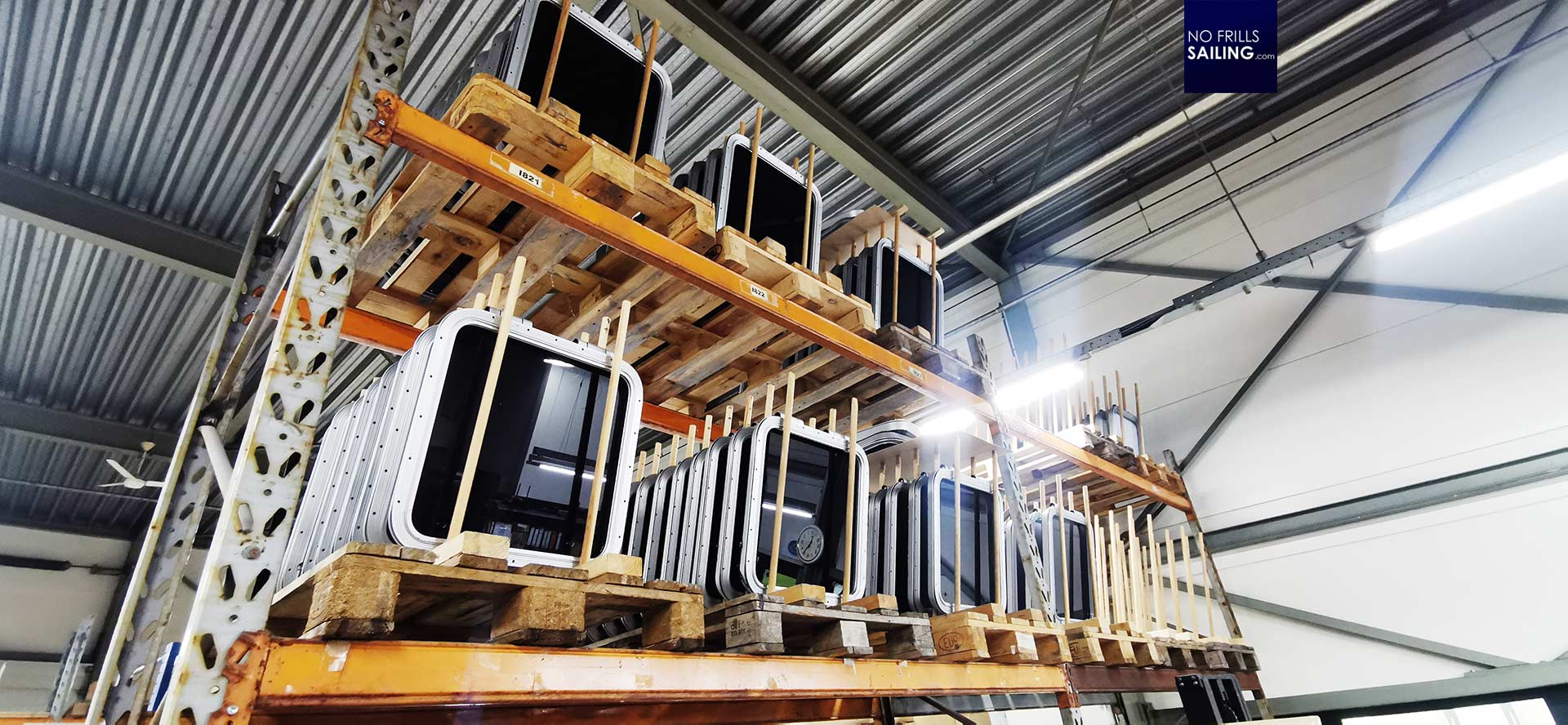
I look around and so I see a couple of hundred pre-sealed glazings in a dozen or so racks drying. It feels as I was in a bakery or sausage factory, with all the hot bread loafs or smoked fumy sausages hung up to dry before being put to the sales room into the display. I didn´t know that making a deck hatch or porthole is such a delicate process for real.
Class, not mass!
After watching the final fitting and packaging of the products. We – for now – end the factory tour in the Gebo warehouse. All of the standard products are in stock. This is the reason why after my initial order it took Alan just a single day to prepare my delivery. I wonder how many pieces this almost 20 people company makes per year. I ask Alan.
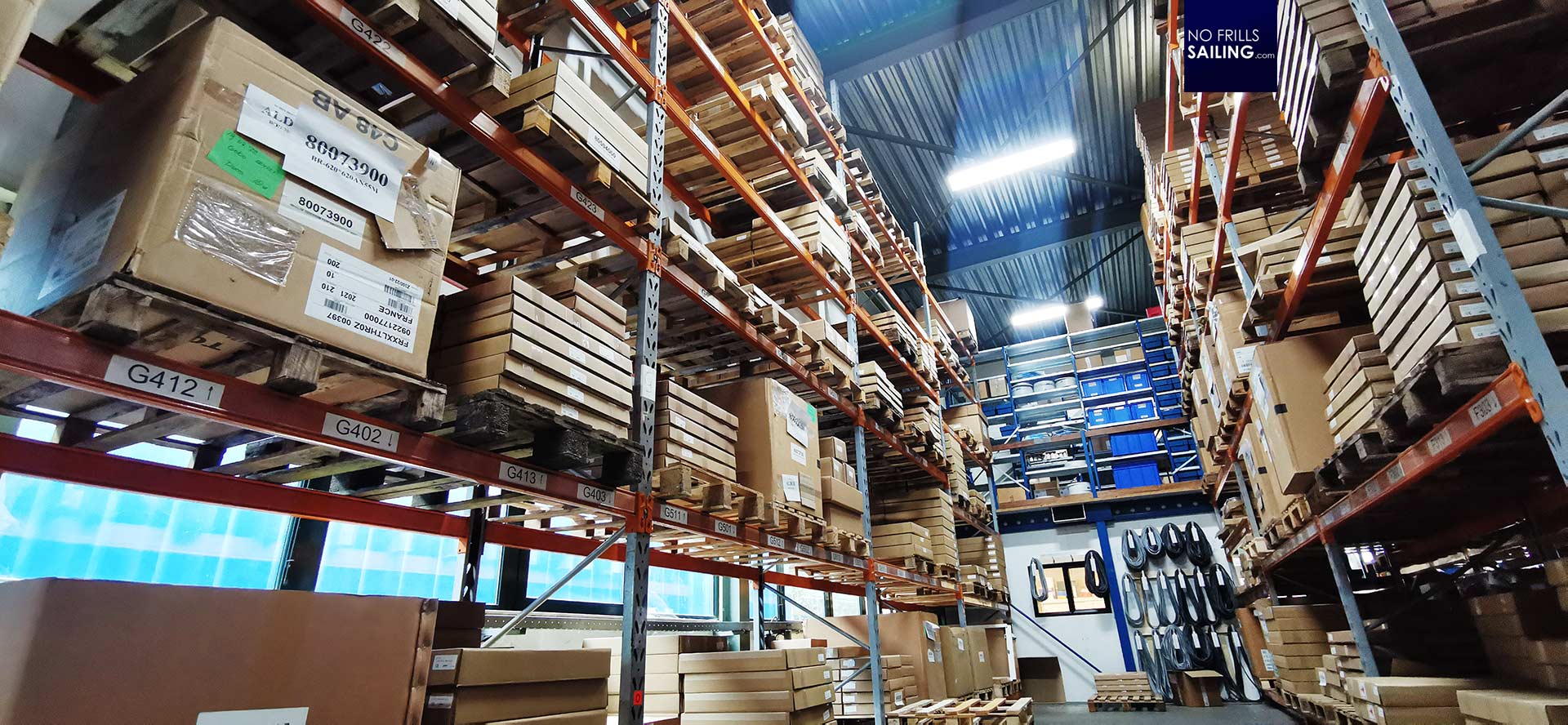
For standard sized deck hatches, portholes and windows, he quickly estimates and re-evaluates in his head, a number around 10.000 individual pieces are produced and sold. I find this figure staggering. Imagine an average of five hatches per boat, this is a fleet of 2.000 yachts per year fitted with Gebo products! From a production-side, given a total of 250 average working days per year, that will make a total of 40 to 50 products made per day: 5 hatches per hour. Amazing, isn´t it?
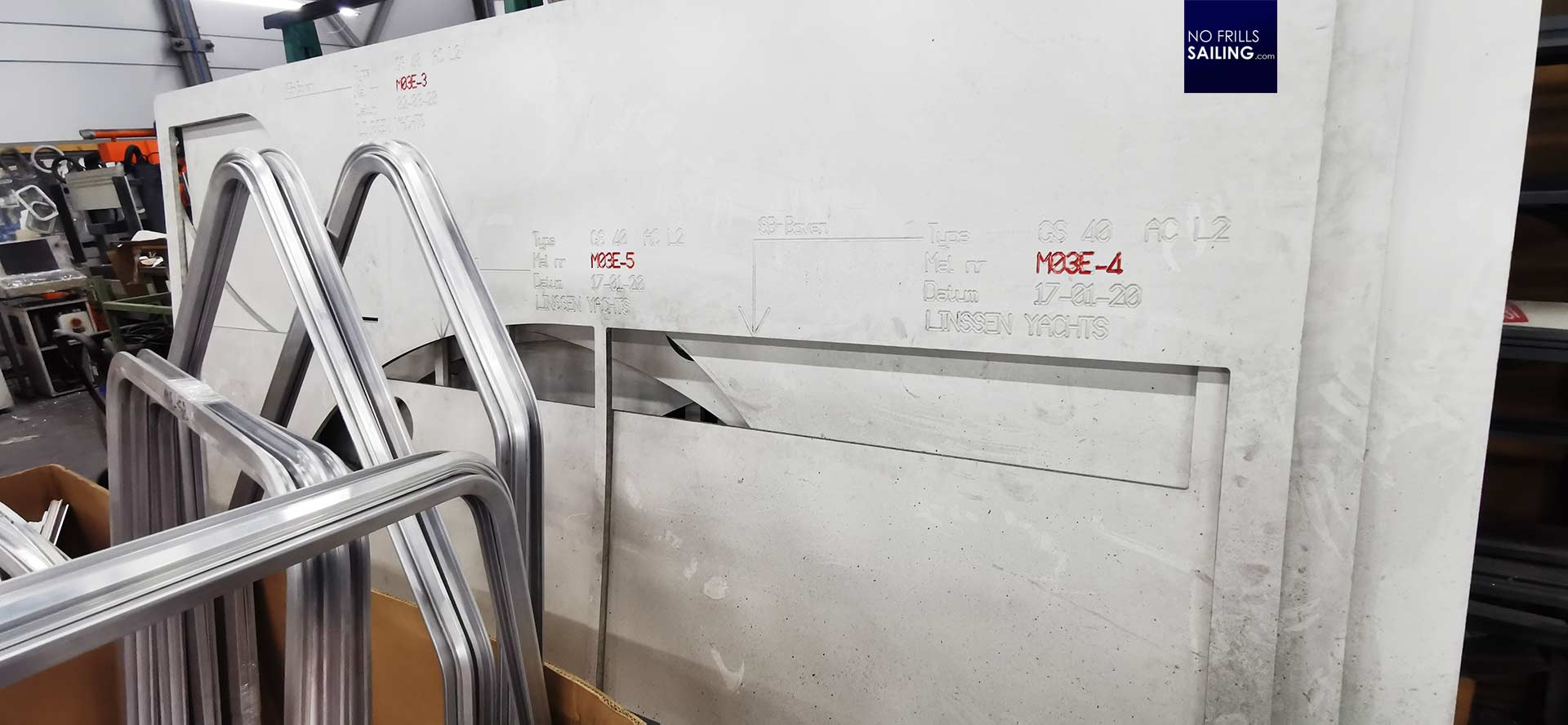
But this is just one half of the Gebo story. Just as with my own new boat, the standard hatches and portholes mostly don´t cover all sizes and more so, all forms, for which marine glazing is needed on a boat. Gebo manufactures fully custom windows and portholes as well. And in this, they are working for the largest and most highly appreciated brands in the boating industry. As I look closer onto one of the gauge models provided for such custom windows, I find engrave the name of an upper brand: Linssen Yachts.
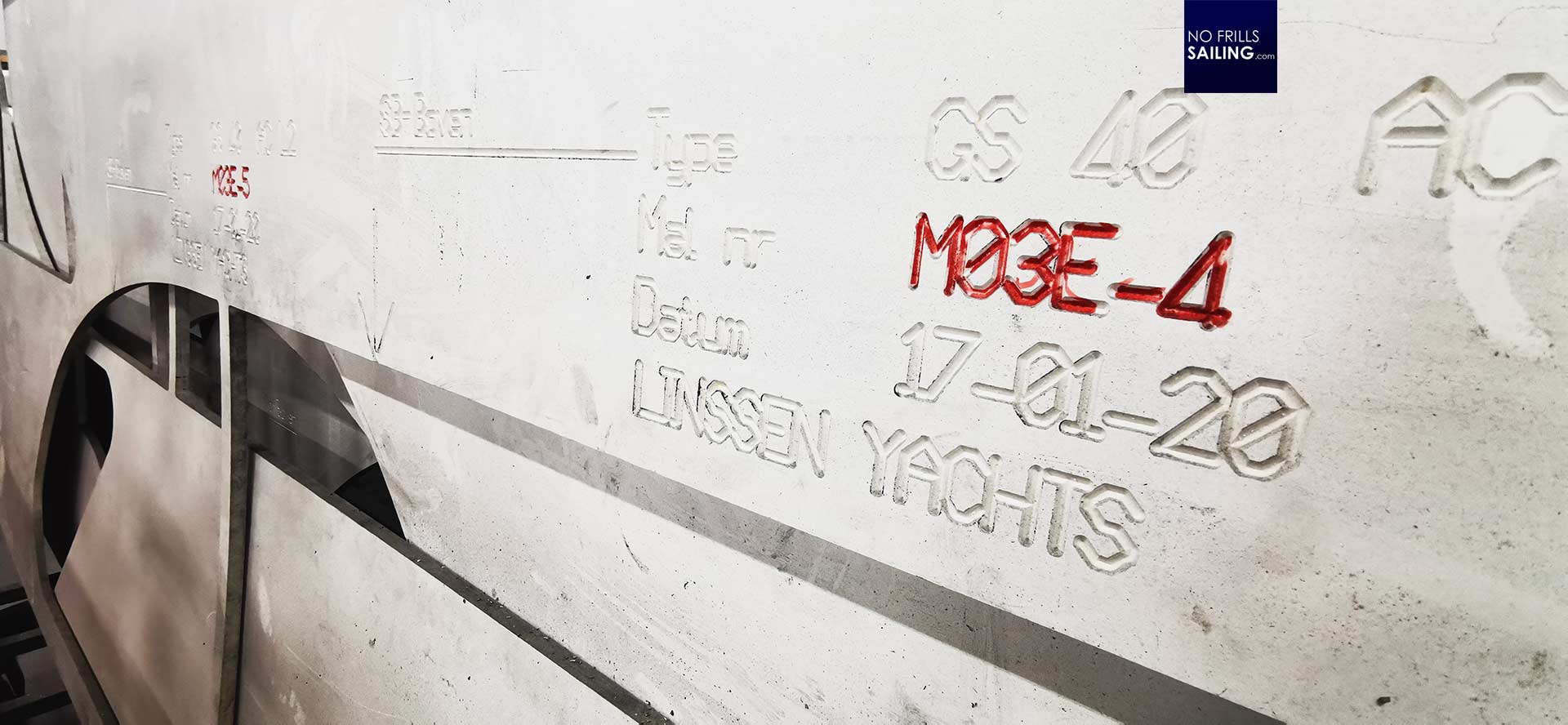
Alan confirms that Gebo regularly makes custom windows and hatches for all sorts of boatbuilders and brands, such as Contest Yachts, Oyster and many more high class brands. But they also deliver to production brands when the usual standard suppliers cannot deliver, such as for Jeanneau Yachts for example. In this, Gebo has no minimum purchase, which is a big thing for me personally.
Custom marine windows: Market leader
As you may know, my Omega 42 does not only have the standard hatches and portholes, but also slim side windows in the cabin´s coach roof. Other than with WINDFAENGER, hull #001 of the new Omega 42 build, I don´t want simple acrylic to be put to the boat. I find this is a too modern detail and does not really fit the aesthetics of the boat – look at this picture for detail. I want the boat to display her original, classy looks as Peter Norlin had designed her initially.
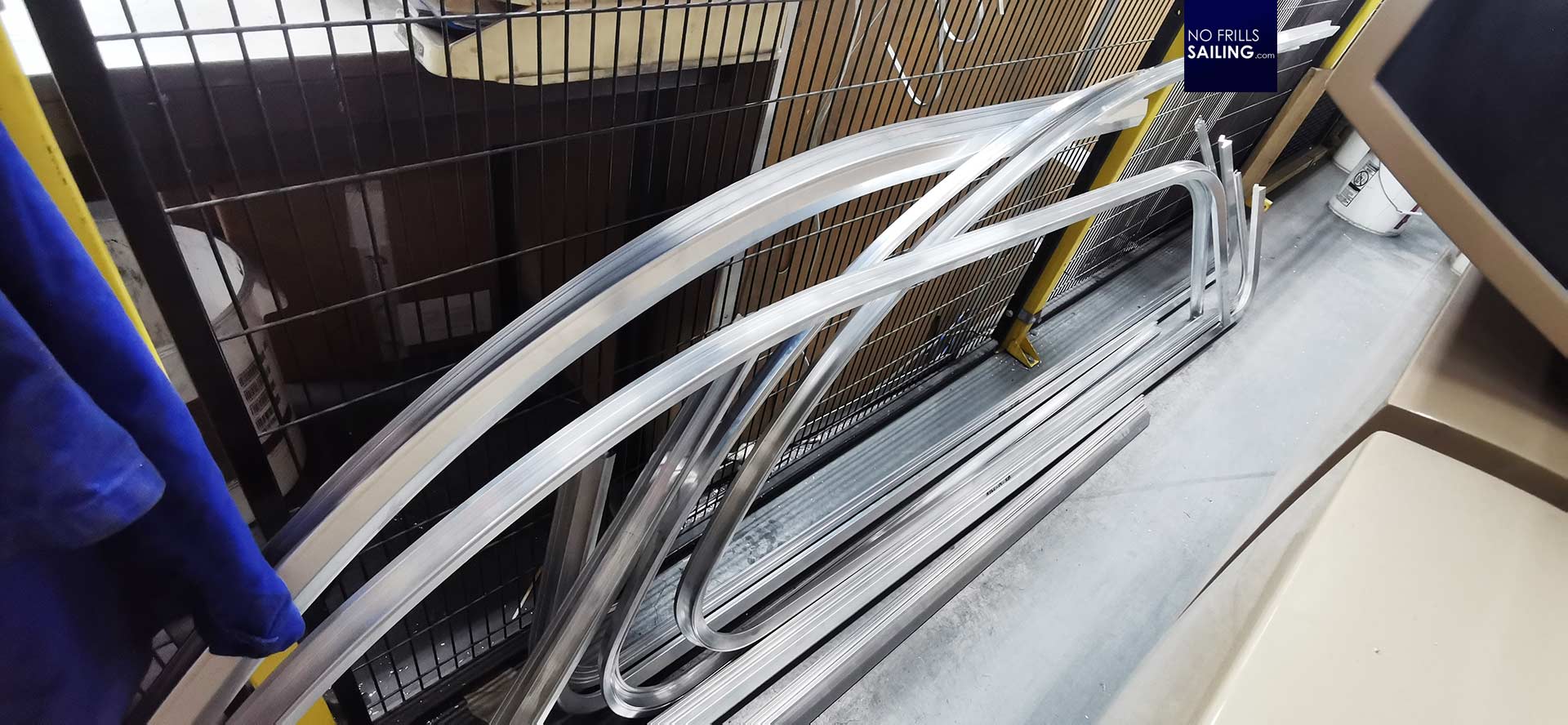
Since those windows are in production for brands like Luffe or Faurby right now, I know that it is possible to do it. Alan explains how it´s done at Gebo. There are basically two ways of sending the data needed to make my custom windows to the company: By model or by digital data. Gauge models may be the easiest way, I guess.

Alan shows me a rack with dozens of such models. Usually they are made from thick cardboard or thin HDF/MDF wooden composite. The models are produced back in the respective shipyards directly at the boat. This technique has the advantage that one can really see and judge if the size and the form are fitting. Just as I documented a few weeks ago, upon sending those models to Gebo these will be digitalized by utilizing the Pro Liner tool. Which, by the way, in itself is a fascinating process!
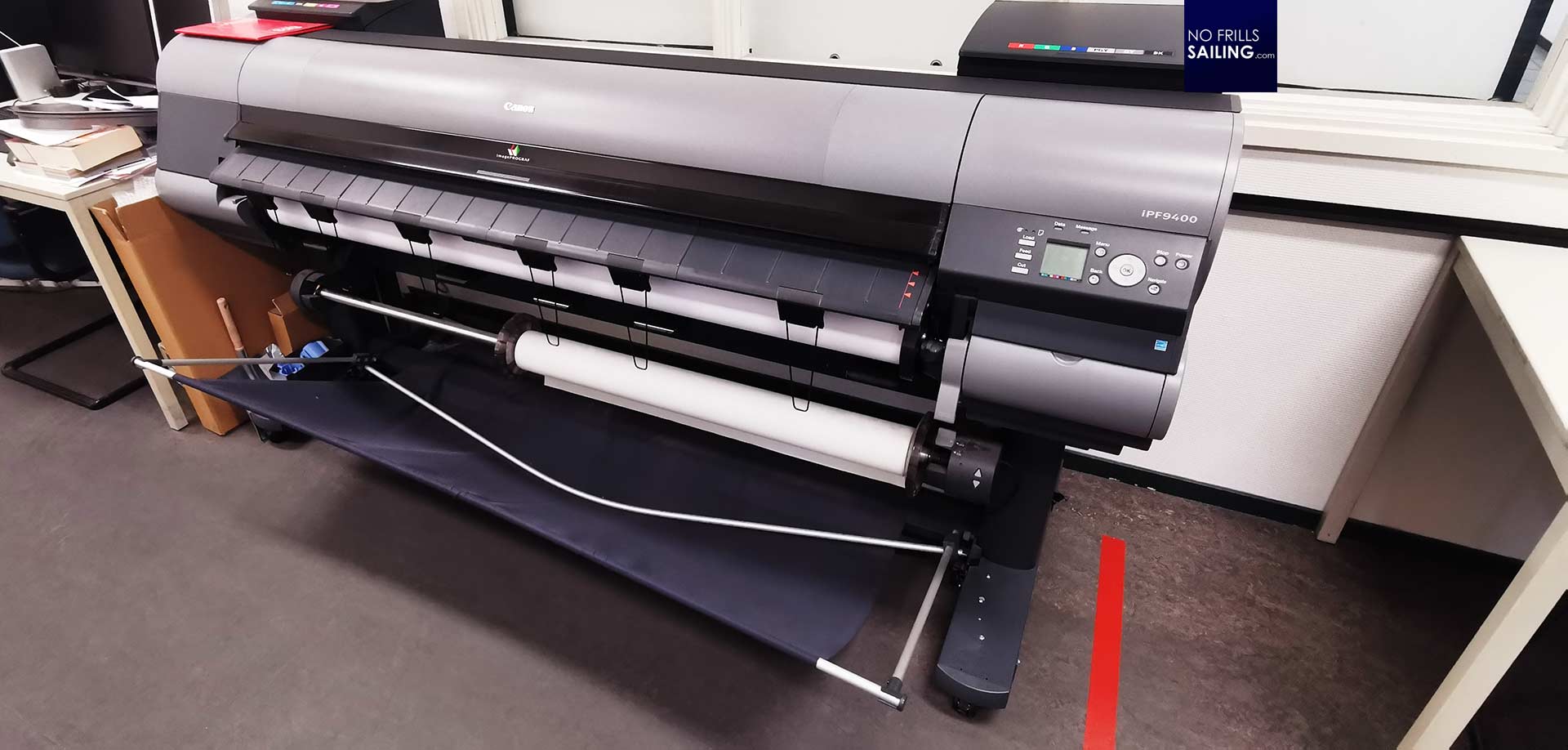
A second way is to deliver digital data in the first place. This is basically a file that contains all measurements of the hatch or window´s shape. Since my partner here in Germany has a Pro Liner tool that´s a way we could do it indeed. In any case, Gebo has a large high precision plotter that will put out 1:1 design drawings which will be used to manufacture the product.
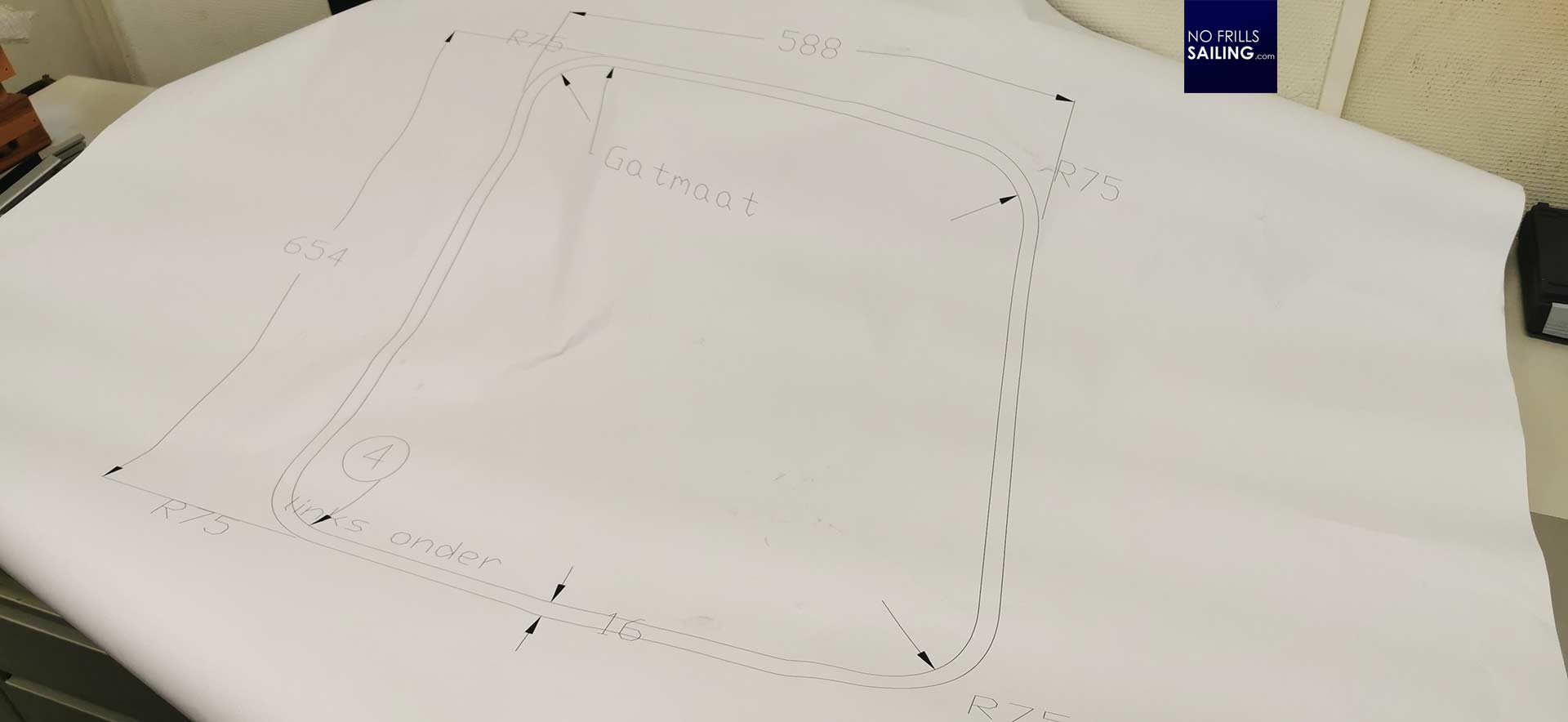
I am still not really sure how I will do it. Right now my plan is to have the deck hatches fitted to the deck of my Omega 42 first. Because the boat has a small opening porthole both in the galley and the bathroom, I need to see them as well as the fixed position of the skylights to be able to decide on the position, size and shape of the two custom made side windows, which will – I am sure – be absolutely decisive for the overall look of ALPHA in the end.
Locally sourced, 100% Dutch
We conclude the factory tour by looking at some very nicely done custom windows. For me, this visit was not just an interesting sidekick, but a very important visit. I am now sure that Gebo is able to make those porthole windows and that those will be absolutely gorgeous. It has its price, for sure – but especially a legendary yacht like the Omega 42 deserves and needs a treatment like this. Oh, and did I mention that a Gebo hatch is a 100% Dutch product?
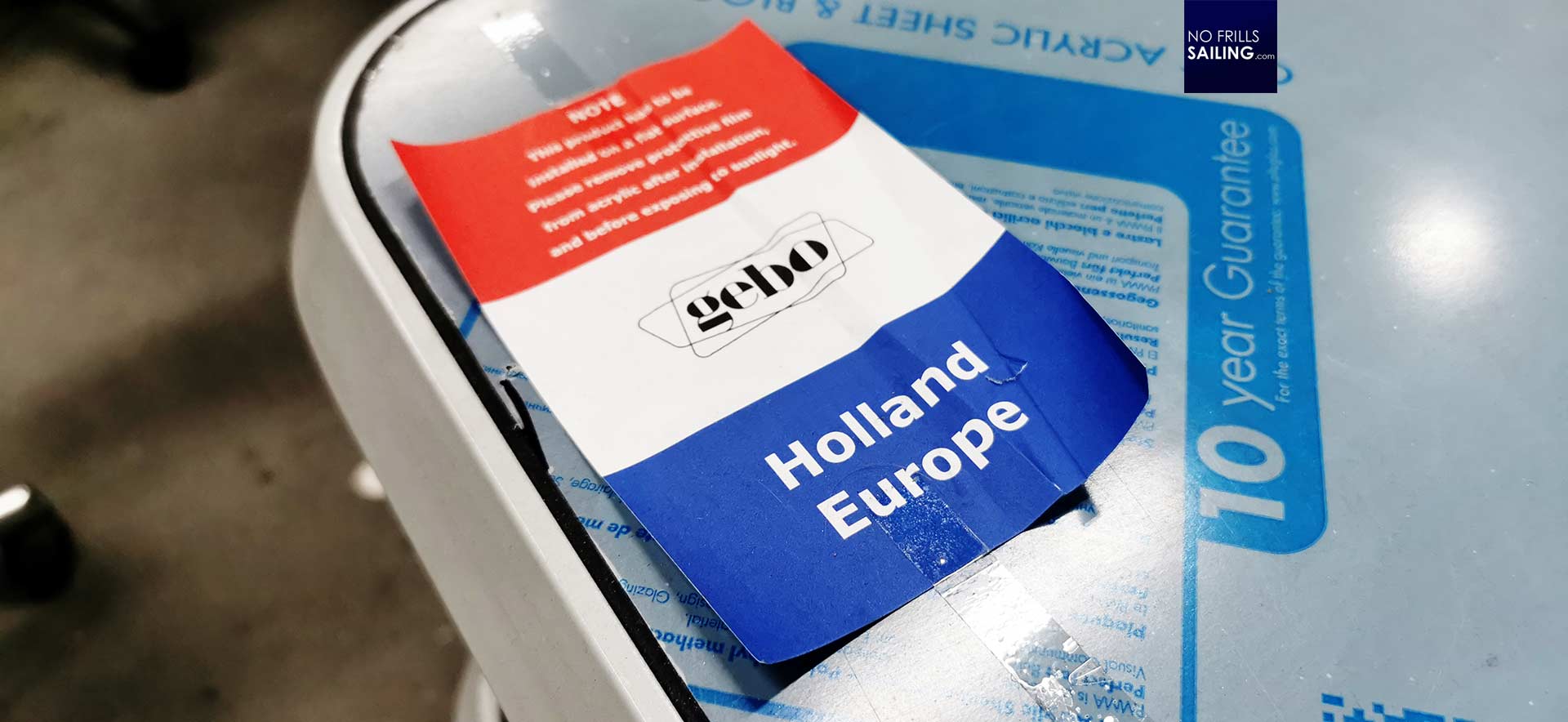
Handcrafted, precision made, locally sourced and certified to be used in rugged environments. It is pure joy to see that there are still companies taking pride in having a high-class quality-aimed production in their home countries. That there are still entrepreneurs and businessmen who seek the best possible product, not the quick revenue by outsourcing to cheap labor countries utilizing cheap raw materials. Gebo, for me, was the one and only choice for the hatches, portlights and windows for my new sailboat – this I am now sure after my visit.
Thanks Alan for the competent and interesting tour of the factory. I am looking absolutely forward to realizing the next four windows for ALPHA with you!
Related articles that might be interesting to you:
High precision handmade boat propellers: At SPW of Bremerhaven
A detailed tour of the Seldén factory in France
Precision, heritage and high quality: Wempe chronometers of Hamburg
